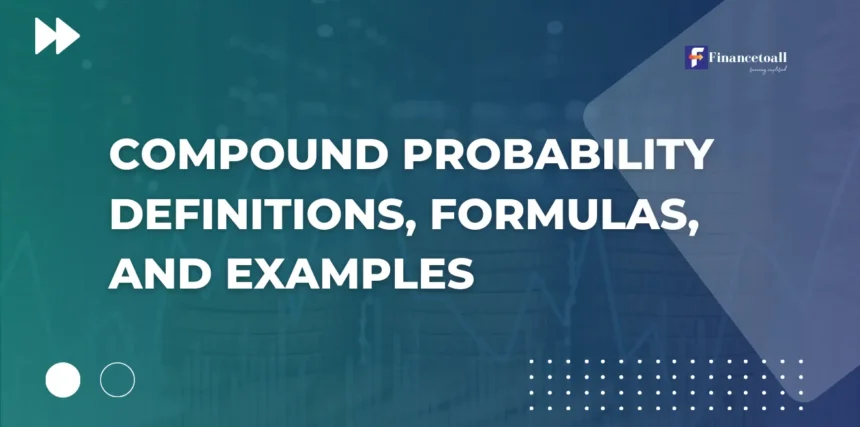Compound Probability is all around us. Whether we’re predicting the weather, calculating the odds of winning a game, or assessing the risks in financial investments, probability helps us quantify uncertainty. In this article, we will dive into Compound Probability, a crucial concept that deals with the likelihood of multiple events happening together. By the end, you’ll understand how to calculate these probabilities and apply them to real-world scenarios.
Key Takeaways
What is Probability?
At its core, probability measures the likelihood of an event occurring. It’s represented by a number between 0 and 1, where 0 means the event is impossible, and 1 means it’s certain.
For example, the probability of flipping a fair coin and getting heads is P(Heads)=12P(\text{Heads}) = \frac{1}{2}P(Heads)=21. To calculate probability, you need to understand key concepts such as:
- Event: The outcome you’re interested in (e.g., getting heads in a coin flip).
- Outcome: A possible result (e.g., heads or tails in a coin flip).
- Sample Space: The set of all possible outcomes (e.g., heads and tails).
What is Compound Probability?
Compound probability refers to the probability of two or more events happening together. These events can either be independent or dependent. The way you calculate compound probability depends on the relationship between the events. Each event must be independent, meaning the outcome of one event does not affect the other. For example, flipping a coin and rolling a die are independent events. The outcome of the coin flip does not change the result of the die roll.
Independent vs. Dependent Events
- Independent Events: When the outcome of one event does not affect the outcome of the other, the events are independent. For example, flipping two coins is an independent event because the outcome of one flip doesn’t impact the other.P(A∩B)=P(A)×P(B) Formula for Independent Events: P(A∩B)=P(A)×P(B)P(A \cap B) = P(A) \times P(B) This means you multiply the probabilities of the individual events.
- Dependent Events: When the outcome of one event influences the outcome of the next, the events are dependent. For instance, drawing two cards from a deck without replacement creates dependent events because removing one card changes the probabilities for the next draw.P(A∩B)=P(A)×P(B∣A) Formula for Dependent Events: P(A∩B)=P(A)×P(B∣A)P(A \cap B) = P(A) \times P(B|A) Here, P(B∣A)P(B|A)P(B∣A) represents the probability of event B occurring after event A has already happened.
Mutually Exclusive vs. Non-Mutually Exclusive Events
- Mutually Exclusive Events: These are events that cannot happen at the same time. For example, when you flip a coin, you can either get heads or tails, but not both.P(A∪B)=P(A)+P(B) Formula for Mutually Exclusive Events: P(A∪B)=P(A)+P(B)P(A \cup B) = P(A) + P(B) This rule applies because the events don’t overlap, so their probabilities can be added directly.
- Non-Mutually Exclusive Events: These are events that can happen together. For example, when drawing cards from a deck, it’s possible to draw a card that is both red and a king.P(A∪B)=P(A)+P(B)−P(A∩B) Formula for Non-Mutually Exclusive Events: P(A∪B)=P(A)+P(B)−P(A∩B)P(A \cup B) = P(A) + P(B) – P(A \cap B) You subtract P(A∩B)P(A \cap B)P(A∩B) because it gets counted twice when adding the probabilities of A and B.
Real-World Applications
Compound probability plays a significant role in various fields. In insurance, companies use it to assess risk. They calculate the chance of multiple claims occurring simultaneously. This helps them set premiums accurately.
In risk assessment, organizations evaluate potential risks by analyzing multiple factors. For example, a company might consider both natural disasters and economic downturns when planning for future stability. Understanding compound probability allows them to make informed decisions.
Examples in Daily Life
Everyday situations also illustrate compound probability. Consider a game where you draw cards from a deck without replacement. The probability of drawing an ace first is 4 out of 52. If you draw an ace, the chance of drawing another ace becomes 3 out of 51. You can find the compound probability by multiplying these two probabilities.
Another example occurs in weather forecasting. Meteorologists might predict the likelihood of rain and wind on the same day. By calculating these probabilities together, they provide a comprehensive weather report.
Importance in Decision Making
Understanding compound probability aids in making better decisions. It provides clarity about possible outcomes in uncertain situations. People often face choices that involve multiple risks or benefits. Recognizing how these factors interact can lead to smarter choices.
Difference Between Simple and Compound Probability
Simple Probability
Simple probability refers to the chance of a single event occurring. For example, flipping a coin has two possible outcomes: heads or tails. The probability of getting heads is 1 out of 2, or 50%. This is a straightforward calculation.
A simple event is an event that cannot be broken down into smaller parts. Rolling a die to get a three is another example of a simple event. The probability here is also 1 out of 6 since there are six faces on the die.
Compound Events
Compound probability involves multiple events happening together. It can be more complex than simple probability. For instance, consider rolling two dice. The outcome depends on both dice. To find the probability of rolling a total of seven, you need to consider several combinations: (1,6), (2,5), (3,4), (4,3), (5,2), and (6,1).
Here, the complexity increases because you must account for all possible outcomes. The total number of outcomes when rolling two dice is 36. Thus, the probability of rolling a seven is 6 out of 36, which simplifies to 1 out of 6.
Combining Events
Simple events can be combined to create compound events. For example, drawing two cards from a deck without replacement creates a compound event. The first card drawn affects the second card’s probability. If you draw an Ace first, only three Aces remain in the deck of 51 cards.
Calculating this requires careful attention to how each event influences the next one. You multiply the probabilities of each step to find the overall chance.
Complementary Events
Sometimes it’s easier to calculate the probability of an event not happening. The probability of an event not occurring is called the complement of that event.
Formula:
P(A′)=1−P(A)P(A’) = 1 – P(A)
P(A′)=1−P(A)
For example, if the probability of it raining tomorrow is 0.3, the probability of it not raining is:
P(No Rain)=1−0.3=0.7P(\text{No Rain}) = 1 – 0.3 = 0.7
P(No Rain)=1−0.3=0.7
Key Concepts in Compound Probability
Independent Events
Independent events are crucial in understanding compound probability. These events do not influence each other’s outcomes. For example, flipping a coin twice results in independent outcomes. The result of the first flip does not affect the second flip. Each flip has two possible outcomes: heads or tails. Therefore, the probability of getting heads on both flips is calculated by multiplying the probabilities of each event.
The formula for independent events is: [ P(A \text{ and } B) = P(A) \times P(B) ]
Event Relationships
Understanding event relationships is vital when calculating compound probabilities. Events can be independent or dependent. Dependent events occur when the outcome of one event affects another. For instance, drawing two cards from a deck without replacement creates a dependent scenario. The first card drawn alters the sample space for the second draw.
In contrast, if you replace the card after drawing, it becomes independent again. Recognizing these relationships helps in correctly applying the formulas for compound probability.
Outcomes and Sample Spaces
Outcomes are specific results from an experiment, while sample spaces include all possible outcomes. Knowing these concepts is essential for determining probabilities accurately. For example, in flipping a coin twice, the sample space consists of four outcomes: HH (heads-heads), HT (heads-tails), TH (tails-heads), and TT (tails-tails).
To find the probability of certain outcomes, count how many favorable results exist within the sample space. For instance, if we want to find the probability of getting at least one head in two flips, we can identify three favorable outcomes: HH, HT, and TH.
Compound Distribution Model
A compound distribution model combines multiple random variables to analyze complex scenarios. It helps predict outcomes in various fields like finance and biology. In finance, it might assess risks across different investments. In biology, it could model cell growth under varying conditions.
By utilizing this model, one can better understand how different factors interact and influence overall probabilities.
Key Takeaways
Key takeaways about compound probability include recognizing independent events and their impact on calculations. Understanding event relationships also plays a significant role in determining accurate probabilities. Finally, knowing how to identify outcomes and sample spaces allows for precise probability assessment.
In summary, grasping these concepts enhances one’s ability to navigate through compound probability effectively.
Formulas for Calculating Compound Probability
Mutually Exclusive Events
The compound probability formula for mutually exclusive events is straightforward. It states that the probability of either event A or event B occurring is the sum of their individual probabilities. The formula can be expressed as:
P(A or B) = P(A) + P(B)
This equation applies when two events cannot happen at the same time. For example, if you flip a coin, it can either land on heads or tails, but not both. If the probability of landing heads is 0.5 and tails is also 0.5, then:
P(Heads or Tails) = P(Heads) + P(Tails) = 0.5 + 0.5 = 1.
The compound probability value in this case equals 1, indicating certainty that one of the outcomes will occur.
Mutually Inclusive Events
For mutually inclusive events, the formula changes slightly to account for overlapping probabilities. This scenario occurs when two events can happen at the same time. The formula is:
P(A or B) = P(A) + P(B) – P(A and B)
Here, you must subtract the probability of both events occurring together to avoid double counting. An example would be drawing a card from a deck where you want to find the probability of drawing a heart or a face card.
If there are 13 hearts and 12 face cards, but one card (the King of Hearts) counts in both groups, then:
P(Heart or Face Card) = P(Heart) + P(Face Card) – P(King of Hearts).
This calculation ensures accuracy by adjusting for the overlap.
Alternative Methods
Several alternative methods exist for calculating probabilities effectively. These include organized lists and area models.
Organized lists help visualize all possible outcomes in a systematic way. For instance, if you roll two dice, listing each combination helps identify total outcomes easily.
Area models provide a visual representation of probabilities using rectangles to represent different events’ areas. Each area corresponds to a specific outcome’s likelihood.
These methods can simplify complex problems and enhance understanding of compound probability concepts.
Examples of Compound Probability Calculations
Coin Flipping
Flipping a coin is a simple example of compound probability. When you flip two coins, each coin has two possible outcomes: heads or tails.
To calculate the compound probabilities, list the outcomes. The possible combinations are:
- Heads, Heads
- Heads, Tails
- Tails, Heads
- Tails, Tails
This results in four total outcomes. Each outcome has a probability of 1/4 or 25%.
Rolling Dice
Rolling dice provides another clear scenario for compound probabilities. When rolling two six-sided dice, each die has six faces.
The total number of outcomes when rolling both dice is 6 x 6 = 36.
For example, if you want to find the probability of rolling a sum of 7, list the combinations that yield this result:
- (1, 6)
- (2, 5)
- (3, 4)
- (4, 3)
- (5, 2)
- (6, 1)
There are six combinations that result in a sum of 7. Thus, the probability is 6/36 or 1/6.
Conditional Probabilities
Conditional probabilities occur when one event affects another. For instance, consider drawing cards from a deck without replacement.
If you draw one card and it’s an Ace, the next draw changes the probabilities. There are now three Aces left in a deck of 51 cards.
To find the conditional probability of drawing another Ace after one Ace is drawn:
- The first event is drawing an Ace.
- The second event is drawing another Ace.
The calculation becomes P(Ace | Ace) = Number of remaining Aces / Total remaining cards = 3/51.
Probability Trees
Using probability trees can simplify complex calculations involving compound distributions. These trees visually represent all potential outcomes and their probabilities.
For example, consider flipping a coin followed by rolling a die. The tree starts with two branches for the coin flip: heads and tails. Each branch then splits into six branches for the die roll.
This visual aid helps track each outcome’s probability easily.
Binomial Distribution
The binomial distribution applies when there are fixed trials with two outcomes. For instance, flipping a coin multiple times fits this model.
If you flip a coin five times, you can calculate the probability of getting exactly three heads using the binomial formula:
P(X=k) = nCk * p^k * (1-p)^(n-k)
Here:
- n = total flips
- k = desired number of heads
- p = probability of heads (0.5)
This formula helps quantify compound results in scenarios with independent probabilities.
Role of Set Theory in Probability
Set Concepts
Set theory forms the foundation of probability theory. It uses sets to represent different events. An event can be a simple outcome or a collection of outcomes.
Unions and intersections are key concepts in set theory. The union of two sets includes all elements from both sets. For example, if set A contains outcomes of rolling a die that are even (2, 4, 6), and set B contains outcomes that are greater than three (4, 5, 6), the union would include (2, 4, 5, 6).
The intersection of two sets includes only the elements that appear in both sets. In the previous example, the intersection would be (4, 6) since these numbers appear in both sets.
Visualizing Relationships
Set theory helps visualize relationships between different events in compound probability. It allows for a clearer understanding of how events interact with one another.
For instance, consider flipping a coin and rolling a die. You can represent the outcomes as two separate sets: one for the coin (Heads or Tails) and one for the die (1 through 6). When analyzing compound events, these two sets can be combined to show all possible outcomes.
Understanding how these events relate is crucial for calculating probabilities. By knowing which outcomes belong to which sets, you can determine the likelihood of various scenarios occurring together.
Venn Diagrams
Venn diagrams serve as an effective tool for representing compound events. They visually display the relationships between different sets. Each circle represents a set, while overlaps illustrate intersections.
For example, if you have one circle for event A and another for event B, the overlapping area shows outcomes common to both events. This visualization aids in grasping complex probabilities involving multiple events.
Insurance underwriters often use Venn diagrams to assess risks associated with different factors. They analyze how various risk factors overlap and affect overall probability assessments.
By employing Venn diagrams, underwriters can make informed decisions about policy pricing and coverage options. This method simplifies complex data into understandable visuals.
How to Calculate Compound Probability
There are two key rules to remember when calculating compound probability:
- Addition Rule: Use this rule for calculating the probability of either event A or event B occurring, particularly with mutually exclusive and non-mutually exclusive events.
- Multiplication Rule: This rule applies when calculating the probability of both events A and B occurring, particularly with independent or dependent events.
Practical Examples of Compound Probability
- Independent Events: Imagine rolling two dice. What’s the probability of rolling a 3 on one die and a 4 on the other? Since these are independent events, the probability is:P(3∩4)=P(3)×P(4)=61×61=361 P(3∩4)=P(3)×P(4)=16×16=136P(3 \cap 4) = P(3) \times P(4) = \frac{1}{6} \times \frac{1}{6} = \frac{1}{36}
- Dependent Events: Suppose you’re drawing two cards from a deck without replacement. What’s the probability of drawing a red card first and a king second? The probability changes after the first draw, making this a dependent event.
Real-World Applications of Compound Probability
Compound probability is more than just theory. It plays a significant role in many fields, such as:
- Insurance: Actuaries use compound probability to assess risks and set premiums.
- Genetics: Scientists calculate the likelihood of inheriting multiple genetic traits based on compound probability.
- Finance: Investors calculate the probability of multiple market events occurring to manage risks in their portfolios.
- Sports: Coaches and analysts use compound probability to predict game outcomes and player performance.
Types of Events in Compound Probability
In compound probability, multiple events occur, and the goal is to determine the likelihood of one or more of these events happening together. These events can be classified into several types, based on their relationships and how their probabilities are calculated. The main types of events in compound probability are:
1. Independent Events
- Definition: Two or more events are independent if the occurrence of one does not affect the occurrence of the other(s).
- Example: Tossing two different coins. The outcome of one coin does not affect the outcome of the other.
- Formula: P(A and B)=P(A)×P(B) where P(A) is the probability of event A, and P(B) is the probability of event B.
2. Dependent Events
- Definition: Two or more events are dependent if the occurrence of one event affects the probability of the other.
- Example: Drawing two cards from a deck without replacement. The outcome of the first draw affects the probabilities of the second draw.
- Formula: P(A and B)=P(A)×P(B∣A) where P(B∣A) is the conditional probability of event B occurring given that A has already occurred.
3. Mutually Exclusive Events (Disjoint Events)
- Definition: Two or more events are mutually exclusive if they cannot happen at the same time (i.e., the occurrence of one event excludes the possibility of the other).
- Example: Rolling a die and getting either a 3 or a 5. You cannot roll both a 3 and a 5 simultaneously.
- Formula: P(A or B)=P(A)+P(B) provided that the events are mutually exclusive.
4. Non-Mutually Exclusive Events
- Definition: Two or more events are non-mutually exclusive if they can occur at the same time.
- Example: Drawing a card from a deck that is both a heart and a face card. These events can overlap.
- Formula: P(A or B)=P(A)+P(B)−P(A and B) where P(A and B) is the probability that both events occur.
5. Complementary Events
- Definition: The complement of an event A is the event that A does not happen. The sum of the probabilities of an event and its complement equals 1.
- Example: If the event A is “getting heads” when flipping a coin, the complement event is “getting tails.”
- Formula: P(A′)=1−P(A) where P(A′) is the probability that event A does not occur.
6. Exhaustive Events
- Definition: A set of events is exhaustive if at least one of the events must occur.
- Example: Rolling a die and considering the outcomes 1, 2, 3, 4, 5, and 6. These events are exhaustive because one of them must occur.
- No Specific Formula: The total probability of an exhaustive set of events is always 1.
Common Misconceptions About Compound Probability
Independent Events
Many people think compound probability only applies to independent events. This belief is incorrect. Compound probability can also involve dependent events. For example, drawing a card from a deck changes the outcome of subsequent draws. The first draw affects the second one. Therefore, understanding how these events interact is crucial.
Mutually Exclusive vs. Mutually Inclusive
Another common misunderstanding is how to add probabilities in mutually exclusive versus mutually inclusive events. Mutually exclusive events cannot happen at the same time. For instance, rolling a die results in either a 2 or a 3 but not both. You simply add their probabilities together.
In contrast, mutually inclusive events can occur together. An example is flipping a coin and getting heads while also rolling an even number on a die. Here, you must consider the combined probabilities carefully. This confusion often leads to errors in calculations.
Complexity of Calculations
e believe that calculating compound probability is overly complex. This myth discourages many from trying to understand it. In reality, the calculations are systematic and straightforward once you grasp the basic concepts.
For independent events, multiply the probabilities of each event occurring. For example, if you flip a coin and roll a die, the probability of getting heads and then rolling a 4 is calculated by multiplying the individual probabilities: 0.5 (for heads) times 1/6 (for rolling a 4).
For dependent events, adjust the second probability based on the outcome of the first event. If you draw a card from a deck and do not replace it, the total number of cards decreases for the next draw.
Understanding these principles makes calculations clearer and more manageable.
Real-Life Examples
Real-life scenarios help clarify these misconceptions about compound probability. For instance, consider insurance underwriters assessing risk. They often use compound probability to determine outcomes based on various factors like age and health status. Each factor contributes to overall risk assessment.
Another example involves games of chance, like flipping coins or rolling dice. Players frequently calculate their chances of winning based on previous outcomes and current conditions. Recognizing whether events are independent or dependent helps them make informed decisions.
Conditional Probability
Conditional probability measures the likelihood of an event occurring given that another event has already happened.
Formula:
P(A∣B)=P(A∩B)P(B)P(A|B) = \frac{P(A \cap B)}{P(B)}
P(A∣B)=P(B)P(A∩B)
For example, what is the probability of drawing a red card from a deck, given that you’ve already drawn a red card? This scenario requires you to adjust the probability based on the previous event, making it a dependent case.
Visualizing Compound Probability with Probability Trees
Using probability trees can simplify compound probability problems, especially when dealing with sequential events. A probability tree visually breaks down each event and its possible outcomes, making calculations easier to follow.
For example, a probability tree for flipping two coins shows the probability paths for each flip and can help you calculate compound probabilities step by step.
Conclusion
Compound probability is an essential tool for understanding the likelihood of multiple events occurring together. Whether you’re dealing with independent, dependent, mutually exclusive, or non-mutually exclusive events, knowing how to calculate compound probabilities can help you make informed decisions in everyday life. By mastering these concepts, you can apply probability to everything from games and sports to finance and science.
Frequently Asked Questions
Q.1 What is compound probability?
Compound probability refers to the likelihood of two or more events occurring together. It combines the probabilities of individual events, using specific formulas to calculate the overall chance.
Q.2 How does compound probability differ from simple probability?
Simple probability measures the chance of a single event occurring, while compound probability involves multiple events. This distinction is crucial for understanding complex scenarios in probability calculations.
Q.3 What are key concepts in compound probability?
Key concepts include independent and dependent events, conjunctions (AND), and disjunctions (OR). Understanding these helps in accurately calculating compound probabilities.
Q.4 What formulas are used for calculating compound probability?
Common formulas include:
For independent events: P(A and B) = P(A) * P(B)
For dependent events: P(A and B) = P(A) * P(B|A)
Q.5 Can you provide an example of compound probability calculation?
Sure! If the probability of rolling a 3 on a die is 1/6, and flipping heads on a coin is 1/2, the compound probability of both events happening is (1/6) * (1/2) = 1/12.
Q.6 How does set theory relate to compound probability?
Set theory helps visualize relationships between events. It uses Venn diagrams to illustrate intersections (AND) and unions (OR), aiding in better understanding and calculation of compound probabilities.
Q.7 What are common misconceptions about compound probability?
Many believe that all events are independent, or they confuse “and” with “or.” Understanding the nature of events is essential for accurate calculations in compound probability.








